Episodes
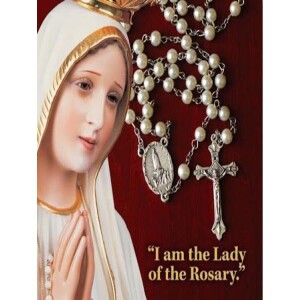
Saturday Oct 07, 2023
Saturday Oct 07, 2023
Stand In The Gap With Us And Our Lady of the Rosary 10/7/2023
In 1571 Pope Pius V called for all of Europe to pray the rosary for victory at the Battle of Lepanto, in which the Christian belligerents included the Papal States. The Christian victory at Lepanto was at first celebrated as the feast of "Our Lady of Victory" on October 7, but was later renamed Our Lady of the Rosary.
Our Lady of Fátima is the title given to the Virgin Mary as she appeared before three shepherd children near the village of Fátima, Portugal, in 1917. She identified herself to them as the Lady of the Rosary. The Roman Catholic Church officially recognized the Fátima events as worthy of belief in 1930.
It is widely believed that in 1214 St. Dominic had a vision of Mary. She is said to have presented him with the rosary, both the beads and the prayers to be prayed. Dominic had a tremendous devotion to Mary and the rosary, which he promoted wherever he traveled to preach.
Add a Hail Mary after grace before meals. Or add a less well-known Rosary-associated prayer before you eat, such as the Hail Holy Queen, the Fatima Prayer or the Apostle's Creed. Note that this could be a special month to read more about and consider doing a consecration to Mary.
Independently from this historical reason, there is a symbolic reason. Ten has the meaning of totality and unity, meaning that each one of Christ's mysteries is part of his total person and work and expresses its unity and totality, as well as its thorough contemplation by the person who says this decade of the rosary.
The Blessed Mother promises that anyone who regularly prays the Rosary, and earnestly tries to live according to God's will, will be spiritually prepared when their time of death comes.] Whoever shall have a true devotion for the Rosary shall not die without the Sacraments of the Church.
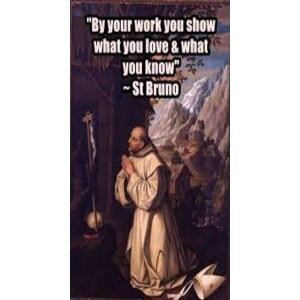
Friday Oct 06, 2023
Friday Oct 06, 2023
Stand In The Gap With Us And Saint Bruno patron of exorcists and possessed persons 10/6/2023
Saint Bruno the Carthusian, also called Saint Bruno Of Cologne, (born c. 1030, Cologne—died Oct. 6, 1101, La Torre monastery, Calabria; canonized 1514; feast day October 6), founder of the Carthusian order who was noted for his learning and for his sanctity.
Bruno. The most important of these is the halo of seven golden stars, which relates to an episode in his vita. The mitre on the ground, a conventional symbol for a saint who has refused a bishopric, refers to his turning down Urban II's offer of the archbishopric of Rheims.
St. Bruno was the founder of the Carthusian Order and was highly regarded for his holy and virtuous life. He is widely known as the St. Bruno was the founder of the Carthusian Order and was highly regarded for his holy and virtuous life. He is widely known as the patron of exorcists and possessed persons and is invoked against demonic possession. and is invoked against demonic possession.
The order was founded by Bruno of Cologne in 1084 and includes both monks and nuns. The order has its own rule, called the Statutes, and their life combines both eremitical and cenobitic monasticism. The motto of the Carthusians is Stat crux dum volvitur orbis, Latin for "The Cross is steady while the world turns".
This saint has the honor of having founded a religious order which, as the saying goes, has never had to be reformed because it was never deformed. No doubt both the founder and the members would reject such high praise, but it is an indication of the saint’s intense love of a penitential life in solitude.

Thursday Oct 05, 2023
Thursday Oct 05, 2023
Stand In The Gap With Us And Saint Maria Faustina Kowalska 10/5/2023
Saint Faustina’s name is forever linked to the annual feast of the Divine Mercy, the Divine Mercy chaplet, and the Divine Mercy prayer recited each day at 3 p.m. by many people.
Our Lady told Saint Faustina: I desire, My dearly beloved daughter, that you practce the three virtues that are dearest to Me--and most pleasing to God. The first is humility, humility, and once again humility; the second virtue, purity; the third virtue, love of God.
In 1981, at the tomb of Sr. Maria Faustina Kowalska in Poland, Maureen Digan experienced a healing from incurable Milroy's disease. Her healing was deemed a miracle through the intercession of Sr. Faustina, which led to Faustina's beatification in 1993.
In His revelations to St. Faustina, Our Lord asked for a special prayer and meditation on His Passion each afternoon at the three o'clock hour, the hour that recalls His death on the cross.
The genesis of the painting was a vision Faustina experienced in 1931 while living in a convent in Plock, Poland. Jesus appeared to her in her cell wearing a white garment, she writes in her diary: “One hand [was] raised in the gesture of blessing, the other was touching the garment at the breast.
JESUS himself revealed the Chaplet of the DIVINE MERCY to Sr Faustina and asked her to pray the Chaplet unceasingly. JESUS told her: Say unceasingly the chaplet that I have taught you. Whoever will recite it will receive great mercy at the hour of death.
Yes, it is true that Jesus promised that the chaplet is a special spiritual remedy for souls at the hour of their death: [Jesus said to her] At the hour of their death, I defend as My own glory every soul that will say this Chaplet; or when others say it for the dying person, the indulgence [pardon] is the same.
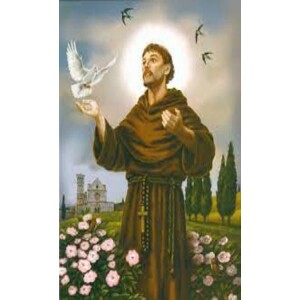
Wednesday Oct 04, 2023
Wednesday Oct 04, 2023
Stand In The Gap With Us and Saint Francis of Assisi 10/4/2023
Francis of Assisi, one of the Catholic Church's most venerated and beloved saints. St. Francis is known for his ministry to the poor and underprivileged, his care for nature and animals, and founding the Franciscan order.
St. Francis of Assisi gave up a life of materialism and wealth and found his purpose in Christ. Throughout his life, St. Francis preached the Gospel and shared his love of all God's creations.
In the work, St Francis wears a brown habit and hold in his hands a human skull. The inclusion of the skull was popular in Counter-Reformation art, as a reminder of man's mortality, a memento mori emblem— “Remember you must die” — emphasising Heaven, Hell, and salvation of the soul in the afterlife.
Francis is one of the most venerated religious figures in Roman Catholic history. He founded the Franciscan orders, including the Poor Clares and the lay Third Order. He and St. Catherine of Siena are the patron saints of Italy, and he is also the patron saint of ecology and of animals.
that where there is doubt, I may bring faith;that where there is despair, I may bring hope;that where there are shadows, I may bring light;that where there is sadness, I may bring joy.
The patron saint of Italy, Francis of Assisi was a poor little man who astounded and inspired the Church by taking the gospel literally—not in a narrow fundamentalist sense, but by actually following all that Jesus said and did, joyfully, without limit, and without a sense of self-importance.
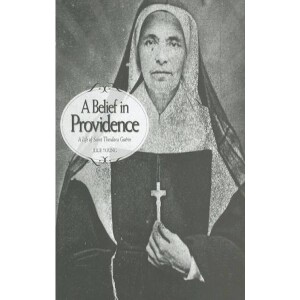
Tuesday Oct 03, 2023
Tuesday Oct 03, 2023
Stand In The Gap With Us And Saint Theodora Guérin 10/3/2023
Patronage. Saint Theodora Guérin has been named a patron saint of: Diocese of Lafayette in Indiana. Knights of Columbus of Indianapolis, Indiana.
From France to Indiana, Saint Mother Theodore Guerin (St. Theodora) lived an impactful life that still continues to inspire. She is remembered as a woman devoted to prayer, an educator, caregiver and leader.
Equipped with little more than her steadfast desire to serve God, Mother Théodore and her five companion Sisters of Providence arrived at the site of their mission at Saint Mary-of-the-Woods, Indiana, the evening of October 22, 1840, and immediately hastened along a muddy, narrow path to the tiny log cabin that served
Trust in God’s Providence enabled Mother Theodore to leave her homeland, sail halfway around the world, and found a new religious congregation.
Born in Etables, France, Anne-Thérèse Guérin’s life was shattered by her father’s murder when she was 15. For several years she cared for her mother and younger sister. She entered the Sisters of Providence in 1823, taking the name Sister Saint Theodore. An illness during novitiate left her with lifelong fragile health, but that did not keep her from becoming an accomplished teacher.
At the invitation of the bishop of Vincennes, Indiana, Sr. Saint Theodore and five sisters were sent to Saint Mary-of-the-Woods, Indiana, in 1840, to teach and to care for the sick poor. She was to establish a motherhouse and novitiate. Only later did she learn that her French superiors had already decided the sisters in the United States should form a new religious congregation under her leadership.

Tuesday Oct 03, 2023
Tuesday Oct 03, 2023
St. Anthony and the mule who knelt down before the Eucharist
St. Anthony of Padua lived during the 13th century and possessed a great zeal for the Real Presence of Jesus in the Holy Eucharist. One day Saint Anthony heard of a man in Rimini named named Bononillo who did not share the same belief. In fact, Bononillo openly mocked people who believed that Jesus was truly present under the appearances of bread and wine. St. Anthony tried his hardest to convince Bononillo with the proofs of scripture and argument, but discovered that the man was as stubborn as a mule. Then St. Anthony received an inspiration. He challenged the wealthy merchant, “If the mule you ride adored the Body of Christ in the Eucharist, would you believe in the truth of the Blessed Sacrament?” Bononillo agreed, but decided to raise the stakes. Bononillo would starve his mule for three days and then bring it to the town square. Saint Anthony would bring the Blessed Sacrament to that same square. The mule then would be put in front of a pile of hay and St. Anthony would stand a few yards away with the Blessed Sacrament. What happened next would decide the victor.
To prepare for the event, St. Anthony fasted for three days, and Bononillo in turn told everyone in the town. Bononillo was convinced that the mule would think nothing of the Eucharist and ravenously eat the pile of hay.
On the day of the test, Bononillo brought his mule and placed the hay under the mule’s nose. St. Anthony came and stood a distance away with the Holy Eucharist. Defying all odds, the mule turned his head and walked over to Saint Anthony. When the mule was close, the animal bent his front legs and kneeled in adoration! When Bononillo saw this miraculous change of events, he immediately knelt down and professed his belief in the truth of the Real Presence.

Monday Oct 02, 2023
Monday Oct 02, 2023
Stand In The Gap With Us On The Feast of the Guardian Angels 10/2/2023
Guardian Angels Day comes around once a year on October 2. It is a day that seeks to recognize the protective roles that guardian angels have in our lives.
Incorporate the Guardian Angel prayer into your daily prayer routine in the morning or at night. Have an “angel” themed meal. (Consider angel hair pasta with angel food cake for dessert! Or how about some chicken wings followed by angel wings for dessert?)
The feast of the guardian angels reminds us that we are not without spiritual help on our journey through life. The watchful care and intercession of the angels are but a reflection of the even greater watchful care and intercession of the Lord.
Originally this feast celebrated only St. Michael, and in some places was even a holy day of obligation. Eventually there arose a request to have a separate feast in honor of the guardian angels, those angelic spirits who are assigned by God to guide and protect each human soul.
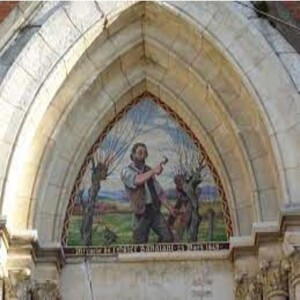
Monday Oct 02, 2023
Monday Oct 02, 2023
Join John Carpenter, Don Hartley, and the Deeper Truth research team as they review the incidents in Vinay, France in 1649.
Pierre Port-Comber, a farmer, abandoned the Catholic Faith for this new heretical group. Mr. Combet grew to reject anything Catholic would purposely work on Sundays and Feast Days as an outward protest.
Pierre was married to a devout Catholic, Jeanne, who bore six children trying to raise them Catholic but Pierre did not respect his vows he made before God and his wife. He brought heresy within his household against his wife's objection. Like St. Monica, she began to intercede for her husband at Mass and the Rosary.
Despite Jeanne's devotion, Pierre would work on Sundays and Holy Days to inflame the Catholic majority. On March 25, 1649, the Feast of the Annunciation Pierre staged himself to work near a road he knew neighbors would travel to make a spectacle. He began to attempt to cut into a willow tree with his knife when he found blood spilling out splashing on him. Thinking he cut himself he wiped off the blood and proceeded to stab the tree and again the tree bleed bright red blood.
Jeanne came by the scene noticing Pierre was covered in blood. Thinking he was hurt she quickly ran to him looking for evidence of a wound. Pierre attempted to explain the strange occurrence so his wife took the knife and cut into the tree with zero blood, not even tree sap noticed. Pierre watching his wife retook the knife and again stabbed into the willow tree and again the bleeding occurs.

Sunday Oct 01, 2023
Sunday Oct 01, 2023
Stand In The Gap With Us And Saint Thérèse of Lisieux 10/01/2023
She is a patron saint of missions and of florists. Thérèse was the youngest of nine children, five of whom survived childhood. After her mother died of breast cancer in 1877, Thérèse moved with her family to Lisieux. In the deeply religious atmosphere of her home, her piety developed early and intensively.
She loved flowers and saw herself as the "little flower of Jesus," who gave glory to God by just being her beautiful little self among all the other flowers in God's garden. Because of this beautiful analogy, the title "little flower" remained with St. Therese.
We can find joy and God in even the smallest actions if we remember why we take them on. “Remember that nothing is small in the eyes of God,” St. Therese says. “Do all that you do with love.”
"I understood that love comprises all vocations – that love is everything, and because it is eternal, embraces all times and places." God is love. We all know this, but we seldom live this way on a daily basis – as if love should be our goal, our focal point, our reason for breathing and being.
“I prefer the monotony of obscure sacrifice to all ecstasies. To pick up a pin for love can convert a soul.”
These are the words of Thérèse of Lisieux, a Carmelite nun called the “Little Flower,” who lived a cloistered life of obscurity in the convent of Lisieux, France. And her preference for hidden sacrifice did indeed convert souls. Few saints of God are more popular than this young nun. Her autobiography, The Story of a Soul, is read and loved throughout the world. Thérèse Martin entered the convent at the age of 15 and died in 1897 at the age of 24.

Saturday Sep 30, 2023
Saturday Sep 30, 2023
Stand In The Gap With Us And Saint Jerome 9/30/2023
Jerome is the second-most voluminous writer – after Augustine of Hippo (354–430) – in ancient Latin Christianity. The Catholic Church recognizes him as the patron saint of translators, librarians, and encyclopedists. Jerome translated many biblical texts into Latin from Hebrew, Aramaic, and Greek.
He was an avid student, a thorough scholar, a prodigious letter-writer and a consultant to monk, bishop, and pope. Saint Augustine said of him, “What Jerome is ignorant of, no mortal has ever known.” Saint Jerome is particularly important for having made a translation of the Bible which came to be called the Vulgate.
'Til your good is better and your better is best". The face is the mirror of the mind, and eyes without speaking confess the secrets of the heart.
Jerome firmly insists that ignorance of Scripture is ignorance of Christ. A strong exhortation from a Father and Doctor of the Catholic Church to Christians urging all to recognize that serious Bible study is a necessity, not an optional luxury.
Saint Jerome has a vigorous sense of active virtue, he aims to modify reality with tenacity, he wants a spiritual rebirth, as a rebirth had happened in the field of letters and arts, he desires the reform of the Church and he works for it, resuming not so much the pagan culture, but the perennial source of the Gospel
Legend says that the saint once removed a thorn from the paw of a lion, which then became his permanent companion. The lion lying protectively in the foreground of the sunlit room represents the taming of human passions.
In portrayals of St. Jerome and other saints, the skull symbolizes our mortality. Memento mori —the memory of death—is something we as Christians should always have in our minds, though not for the sake of meaningless morbidity.
